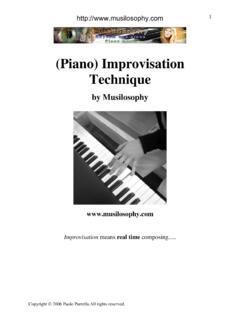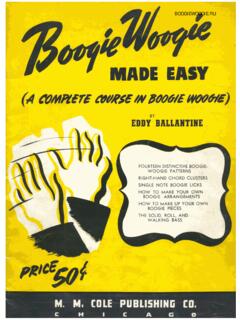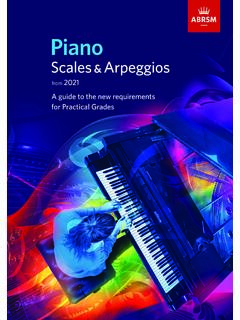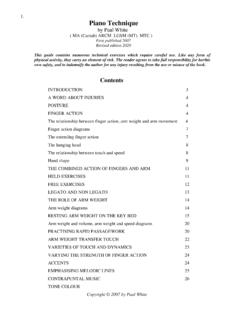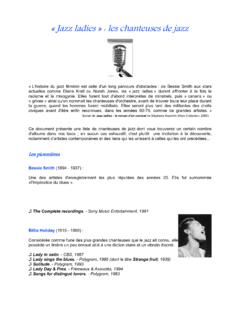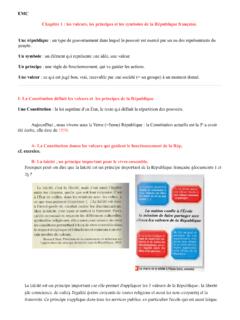Transcription of STEPS TO THE REAL BOOK - JamesLevyMusic.com
1 STEPS TO THE real BOOKA basic Jazz Piano TextBy James Levy 1992-2004 1992-2004 James "Fake Books and real Books and Charts (Oh my!).."Once upon a time, before the rise of the electric guitar, back in the dim dark past of the early 1900s, Americans out for a night on the town were serenaded by live groups of musicians. With names that often included the word "Orchestra" or "Band," these groups had not only piano, guitar, bass and drums, but trumpets, trombones, saxophones (who "doubled" on clarinet and flute) -- and some groups even sported violins. In order to play the music of the day these orchestras had arrangements, sometimes bought off the shelf--these were called "stock" arrangements or "stock" charts --but also sometimes arranged specifically for the group itself. Duke Ellington was the preeminent example of a band leader/ arranger/composer/genius. Groups that specialized in the blues often extemporized songs that, in turn, became fixed arrangements, for example Count Basie's "One O'clock Jump.
2 "In order to augment their repertoire, groups would also obtain "Fake books," books of songs in lead sheet format. These books were often published illegally, without obtaining and paying copyright, and, in a hurry to get the latest hits out there, rife with mistakes. The musicians would then "fake" like they had an arrangement and derive parts from the lead sheet, also adding their own vocabulary, that would correspond to their regular role in the , sometime in the 1960s, in Boston, Massachusetts, some people decided they would make The real book As they say in their Forward (quoted here without permission) The real book is the answer to the fake book . It is an alternative to the plethora of poorly designed, illegible, inaccurate, badly edited volumes which abound on the market real book was painstakingly created because the editors care about music and want it to be well played and fun to play by you, the musician.
3 "Enjoy!"The real book , while being an illegal, underground publication, found its way around the world and was and is used widely by students of jazz. While the consensus is that they did a very good job of selecting tunes to put in "The real book , the book does indeed contain errors, in a few cases it's almost as if they made up a new song ("Blue Train" by John Coltrane). It spawned the real book 2, 3 and a host of other illegal 1988 "The New real book " was published by Chuck Sher. This legal book contains both lead sheets and arrangements and is a big step up from The real book in terms of accuracy, in many cases the composers themselves reviewed the lead sheets. Then in 2004, Hal Leonard came out with a legal version of the classic The real book 6th edition, basically the same tunes as the original, but with the mistakes approach to becoming a jazz piano player is to learn how to interpret lead sheet format such as is found in The real book .
4 Another approach is to work on playing by ear. STEPS to the real book helps to foster both approaches. 1992-2004 James of the book This workbook is intended to help a pianist who already has basic technique and music-reading ability to learn to improvise and to use "The real book ." This book 's helps you learn: To play by ear To read and perform jazz rhythms To construct the basic chords and scale/mode forms used in jazz. Basic harmony and to develop the ear and musical imagination through 1) playing simple folk music in a variety of keys and styles and 2) singing melodies using solfege. To play a blues progression. A theoretical framework for learning chord progressions. To play the most common chord voicings To begin to improvise. Table of ContentsIntroduction: Structuring your practice time: a 5-part scheme 2 First Assignments in each of the 5 partsI. Warm-ups 6II. Applied TheoryII A. Rhythm Exercises 8 Introduction to Scale Construction12II B.
5 Circle of 5ths; basic patterns for practice13 The metronome in Jazz15II B. (cont) Basic Chord Terminology16 Intervals17II B. (cont) 4 note chords, 7th, 6th and add918 Scales/Modes19 III. Pieces21IV. Tunes and Folk Songs22V. ImprovisationA. Basic Pop improvisation : The 4-bar vamp25B. Basic 12-Bar Blues Improv26 Harmony 00128 Past the BasicsTwo analogies and two pet peeves31 Some hints on Jazz improvisation32 Material for advanced circle of fifths practiceVoicing Chords36 Chord Substitutions and Progressions38 Reharmonizing a tune42 1992-2004 James 2 INTRODUCTION TO STEPS TO THE real BOOKS tuff to read and think about before you sit down and practiceWhile it is helpful to first look through the entire book for an overview, much of what is contained here are concepts, activities and exercises that will only be fully understood after hours of practice at the keyboard. Also, despite the fact that the book is full of suggestions as to how to spend your practice time, it is important to always take the initiative, to think up new exercises and gnu is a workbook, write in it, add to it!
6 One of the most important things for someone who wants to play Jazz is to develop a good practice routine. Below is an outline that covers five important practice areas. To cover it all in an hour, I would split the time up as indicated. Every practice session doesn't have to have all 5 parts, but try to cover all 5 most of the time. I. technique -- warm ups, exercises and scales10 min II. Theory -- rhythm and circle of fifths15 min III. Pieces 10 minIV. Tunes15 minV. improvisation 10 minA "Piece" is something that either has every note written out or, even if it isn't fully notated, is something that you are working on playing basically one way. For aspiring Jazz students, as you begin to work with lead sheet format, count that time as working on a "piece," since the new challenge of reading and forming chords while playing the melodies with a true swing feel is enough to keep you occupied. In general, the "piece" part of your practicing has you working on the most difficult "Tune" part of your practicing has you dealing with a melody and chord progression -- both of which are subject to interpretation and change.
7 Typically you will use material that is easy enough for you to play by ear and to play in a variety of keys, styles and textures. Four different versions is a good target." improvisation ," at least the standard type of improvisation in Jazz and popular music, means creating melodic ideas over a repeating chord progression. At first most of the improvisation will happen in the right hand, while the left hand keeps the chord progression. In order to really jam using a " real book ," it is not enough to simply learn to read the chord symbols and to know how to swing. You must also be able to play by ear and be familiar with the basic conventions of Jazz harmony. Learning to improvise means that two things must be developed: the creative imagination and the ability to play by ear. Playing by ear is developed by singing (esp. with the solfege syllables--do, re, ), playing tunes in different keys and "picking out" tunes on the piano.
8 The creative imagination is developed every time you learn a new song (story) and every time you tell an old story with a new twist. Taking a solo in Jazz has traditionally been described as "telling a story." 1992-2004 James saxophonist Illinois Jaquet, in an interview for Dizzy Gillespie's memoirs "To Be Or Not To Bop," offers this insight;You see in Louisiana, where I think that Jazz was born--I was born in Louisiana, so quite naturally ever since I can remember, we've been listening to Jazz music--From the time when they played it right from the ear because there was no time to study music, I imagine they just that song, learn it fast learn it slow, play it in waltz time. It was the same (To Be Or Not To Bop, p. 146)**The Practice routine: Like learning a (Analogies 001)Learning to play Jazz reminds me of learning to speak a foreign language. Most of the activities that go into learning another language have their counterpart in Jazz study.
9 One of the most important activities for language students is listening to a native speaker; some students will even spend a semester or year abroad. For a student to gain an authentic Jazz sound, immersion in Jazz listening, both live and recorded is essential. One Jazz player I know said that he thought it was beneficial to listen to the same record every day for several weeks until you can "hear the record in your head."I. technique is like dictionSimple technique exercises such as scales and Hanon have their counterpart in the phonetic and diction drills that students must do in order to learn foreign sounds. Just as we exaggerate pronunciation when we do diction exercises, we exaggerate finger motions in many technique exercises. In terms of playing by ear, part of the technique is to be able to sing what you play. II. Theory is like grammarOne of the most important requirements for beginning fluency is pattern drills.
10 A linguistic example would be repeating, over and over, "I am, you are, he is, etc." In music, rather than matching the same verb with all the different possible subjects or tenses, you match the same musical idea (chord, scale, riff or song) with all twelve keys. Practicing in all keys has been part of the keyboard improviser's training for centuries. Two of the most important "classical" authors on the subject, Carl Czerny and Bach make this point repeatedly in their treatises. The importance of this activity can only be appreciated after some degree of mastery. In addition to learning the specific materials in all keys, one also learns the general feel of each key. When a idea is played in only one key, that idea may be remembered a variety of ways, by sound, by feel, or even by the names of notes. When an idea is learned in all keys it then becomes more efficient for the mind to remember it in terms of sound -- the most musical way of thinking Then through intensive practice over time, a layer of cognition is developed which functions to put the idea into the specific key, without any conscious, mechanical thought on the part of the performer.
